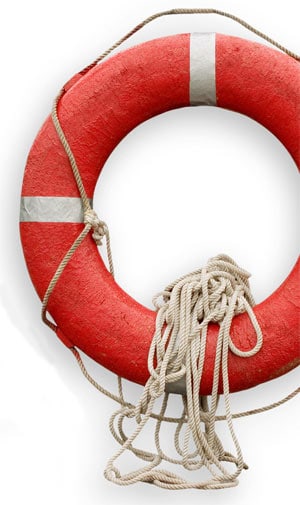COVER STORY: STAYING AFLOAT
By Laurence Neville
With emerging markets economies just holding their own in the face of the crises in the developed world, they are unlikely to be able to pull the world out of the latest economic slump. The question is, who can?

Figures released by the IMF at the end of September confirmed what many feared: Global growth is under pressure. After a strong 2010, a slowdown due to the end of the inventory cycle and fiscal consolidation was inevitable. Japan’s natural disasters and African and Middle Eastern shocks to the oil supply made growth tougher still. However, as the IMF notes in its World Economic Outlook: “Now that the numbers are in, it is clear that more was going on.”
What was going on, according to the IMF, is that the steps needed to rebalance the global economy—the shift from government spending to private demand in developed countries and from exports to domestic consumption in emerging market economies—have failed to occur. Government spending in the west has been slashed but has not been replaced by private demand. Plans by emerging markets countries to boost consumption remain nascent.
Both the US and eurozone countries lived beyond their means for decades, according to Maarten-Jan Bakkum, strategist, emerging markets equity, at ING Investment Management (IM), which has €326 billion in assets under management. “The advance taken on future growth will have to be back paid,” he says. “It will not be possible to maintain current prosperity levels.”
AT THE CROSSROAD
Meanwhile, uncertainty is mounting in global markets given the absence of clear leadership in those economies most affected. Michala Marcussen, global head of economics at Société Générale, notes: “The euro crisis is now threatening [to become] a global systemic crisis,” with contagion spreading beyond periphery European countries. In the US, the repercussions of the failure to reach a political consensus extend far beyond its undignified downgrade by Standard & Poor’s in August.
The world is at a crossroad. There is a desperate need for global growth, and companies and investors need to know where it is coming from and what will drive it. However, the source of economic expansion is unclear. Does Europe’s focus on austerity mean it has no possibility of spurring growth? Will the Obama stimulus plan kick-start the US economy? And—crucially—do emerging markets countries have enough firepower and flexibility at their disposal to pull the world out of a new global downturn?
“China, of course, is the key, but the world will have to count less on it this time because the country simply cannot provide more stimulus.”
– Anthony Chan, AllianceBernstein
THE TRAGEDY OF EUROPE
Both action and inaction on Europe’s debt crisis appear to lead to a worsening of the region’s predicament. This is not entirely the fault of politicians. “Markets are demanding contradictory changes,” says Darren Williams, senior European economist at investment management firm AllianceBernstein. “One moment they are pushing for greater austerity and then indicating they don’t believe austerity will work because it will reduce growth and make it harder to reduce debt.”
 |
|
Chamie, RBC Capital Markets: Emerging markets countries went into the last crisis with low debt and deficit levels and little domestic credit leverage |
Nevertheless, European policymakers and the European Central Bank made a number of errors that exacerbated the growth challenges faced by the region. First, they mishandled Greece’s problems—allowing the crisis to jump into Italy and Spain and ultimately to impact the real economy of core countries, according to Williams. Fear of contagion has prompted market turmoil and resulted in an interbank lending drought that came close to paralyzing Europe in early September.
Although the ECB (in coordination with the Federal Reserve in the US) stepped in to provide access to dollars, understandable caution on the part of banks is creating tighter credit conditions. “Access to credit for households and small- and medium-size companies is expected to deteriorate further over the next couple of months,” says Valentijn van Nieuwenhuijzen, head of strategy and tactical asset allocation group at ING IM. “Moreover, reduced liquidity in capital markets also means that larger-sized companies with direct access to capital markets have less room to maneuver than before—or at least [face] higher costs.” In combination with falling equity prices, this has created an additional tightening of financial conditions in the eurozone and the UK that will further curtail growth.
NO FISCAL STIMULUS
Aside from resolving the debacle of Greece, what could Europe do to stimulate growth? Van Nieuwenhuijzen, points out that in 2009, between 1% and 2% was added to growth as a result of fiscal stimulus in Europe, including temporary measures to create demand for autos. “It is therefore surprising—and worrying—that there is no willingness to support growth with fiscal stimulus now,” he says.
Of course, countries on Europe’s periphery cannot help on the fiscal side: They are consolidating—driven by markets and, where help has been sought, by the imperatives of the IMF. “Elsewhere, with the exception of Denmark, there are few governments willing to use their available firepower despite the low costs of tapping the bond market for funds for a stimulus package,” notes van Nieuwenhuijzen. “Instead, the ideological drive for austerity is prevailing. The mind-set is simply that there is too much debt on government balance sheets and, as German finance minister Wolfgang Schaeuble says, ‘You can’t fight fire with fire.’”
Instead, Europe’s emphasis is on structural changes rather than fiscal measures as a route to growth. To be sure, structural changes are essential: The inefficiency of some southern European countries is staggering. Nevertheless, as Williams notes, structural reform takes a long time to have an impact. “It is certainly not a quick fix for eurozone countries with problems,” he says. Moreover, membership in the eurozone is a huge barrier to improving competitiveness because member countries cannot devalue their currency.
Europe does still have some monetary tools at its disposal. “In theory, the ECB could lower rates by up to 1.5 percentage points ,and it could also undertake some form of quantitative easing, which would give a big boost to market sentiment,” explains Williams. However, Europe is hobbled by the need for agreement among the 17 members of the eurozone and the divergence of opinion between its strongest member—Germany—and the ECB. “It’s difficult to know whether European policymakers and the ECB can now act decisively enough, given the diversity of views in Europe,” adds Williams.
THE US: DIVIDED
The firepower marshaled by the US in the immediate aftermath of the collapse of Lehman Brothers was awesome to behold, and played a central role in the global recovery. The country has since been chastened by a historic downgrade, has failed to address many of its economic challenges and is torn by political division.
However, as Jerome Booth, head of research for the emerging markets investment management firm, Ashmore Group, observes: “The prestige of the country and its size and dominance has enabled significantly more time to pass before the choice need be made between having either a major fiscal stimulus or major fiscal adjustment.”
In early September, President Obama chose the stimulus option with the $447 billion American Jobs Act, although as David Resler, former chief US economist at Nomura, notes: “In an environment keenly sensitive to the need for long-run fiscal discipline… the president promised to pay for this short-run increase in the deficit by cutting future spending or taxes more deeply.” The act combines tax proposals—including extending the duration and scope of a payroll tax break—and spending proposals—including grants for hiring teachers and infrastructure spending. Nomura estimates that based on standard macroeconomic models, a 1.5% to 2.5% boost to growth in 2012 might be expected were the act to become law.
The caveat to this promise of growth is that ideological divisions in Congress make it extremely unlikely that the entire Act will be passed. “Obama’s package of employment tax cuts, infrastructure spending and unemployment insurance initially provoked a positive response and even attracted Republican support,” says Percival Stanion, head of asset allocation at Baring Asset Management. “Unfortunately, more-recent speeches reiterating the demand for more-equal taxes on the superrich have ensured this Republican support has evaporated.”
Moreover, many of proposals are at odds with existing measures aimed at reining in the deficit: the US is emphasizing its prudence and ambition to restore budgetary balance while simultaneously promising largesse to stimulate growth. “Without the stimulus package, the fiscal measures already put in place will result in a 1.5% percentage point detraction from growth,” explains ING IM’s van Nieuwenhuijzen. “If, as is likely, only some of the Obama proposals are enacted, it might be possible to reduce that drag to a percentage point.”
The monetary policy options of the US are equally constrained. With no room for rate reductions, the Federal Reserve appears set for a third bout of quantitative easing. Yet each successive policy announcement produces diminishing returns. The Operation Twist plan to sell short-dated treasuries and buy long-dated bonds in order to lower long-term borrowing costs was received with little excitement: It seems unlikely that the Fed has a killer blow held in reserve that could kick-start growth.
CAN EMERGING MARKETS SAVE THE WORLD, AGAIN?
The importance of emerging markets to the global economy shifted the financial and political landscape in 2008 and 2009 in ways that will continue to be felt for generations. Major emerging markets countries went into the crisis with very low debt and deficit levels and very little domestic credit leverage, recalls Nick Chamie, head of emerging market research at RBC Capital Markets. “As well, they generated immense trade and current account surpluses, affording them significant flexibility in their balance of payments,” he says.
 |
|
Van Nieuwenhuijzen, ING IM: The ideological drive for austerity is prevailing |
In their massive response to stimulate their economies—and the world’s—emerging markets have subsequently seen their government deficit and debt levels rise, a large surge in household debt loads and a notable decline in trade and current account surpluses. Consequently, the prospects for fiscal stimulus look less encouraging than they did in 2008, according to Anthony Chan, Asian sovereign strategist at AllianceBernstein. “Many Asian governments are still in the normalization phase after the large fiscal stimulus implemented only three years ago,” he says. “China, of course, is the key, but the world will have to count less on it this time because the country simply cannot provide more stimulus.”
At the same time, Chamie notes that many leading emerging markets have economies running near capacity and are attempting to deal with overheating pressures, including high inflation, large capital inflows, growing asset bubbles. Van Nieuwenhuijzen agrees: “These problems are manageable, but they indicate that the potential for action to benefit the global economy—rather than the domestic economy—is limited. If there is a sustained down move in food and commodity prices, it would increase [their] room to maneuver.”
However, without that, most emerging markets countries will be looking inward, managing their own challenges in order to land on their feet—which may be the best they can hope for as the global downturn looms.
DOWNWARD PRESSURE
All revisions to growth expectations in recent months have been downward: In its most recent World Economic Report, the IMF forecasts global growth of 4% in 2012—down 0.5% on its prediction just six months earlier. Plenty of forecasters are more pessimistic still, with Citi expecting just 2.9% growth globally and Fitch Ratings just 2.7%. As one economist notes: “It’s a race to get below consensus.”
 |
|
Williams, AllianceBernstein: Markets are demanding contradictory changes |
The expectation is that emerging markets will remain relatively robust. The IMF expects growth of 9% in China and 7.5% in India in 2012. Unfortunately, all the risks are on the downside. China’s export dependence makes it vulnerable, should developed-world demand plummet. Moreover, one potential risk is the exposure of many of China’s banks to the domestic property market, which is cooling rapidly. “For now, we believe systemic risks remain contained [should there be a failure of a prominent property developer],” says Chamie at RBC.
In the developed world, the outcomes range from miserable—anemic growth of 1.8% in the US and 1.1% in the eurozone, according to the IMF—to catastrophic. ING IM estimates the probability of recession in the eurozone and the UK at more than 50%, while Goldman Sachs predicts a 40% probability of stagnation (growth of less than 0.5%) in the US and Europe.
For the immediate future, the crucial issue remains Greece, and the impact of a default on the eurozone and the world.“The fallout from a sovereign and banking crisis would be huge,” says van Nieuwenhuijzen at ING IM. “The potential is there for a global recession. The probability of such an event remains low—at 10%—but it is higher than [it has been] for decades.”
With almost all economists agreed that a default of Greece is inevitable at some point, the question is whether the eurozone can stave off default long enough to put in place a solution that would prevent a banking crisis and a collapse of global confidence. “That the world is dependent on policy action in Europe is far from a comforting prospect,” says Williams.



